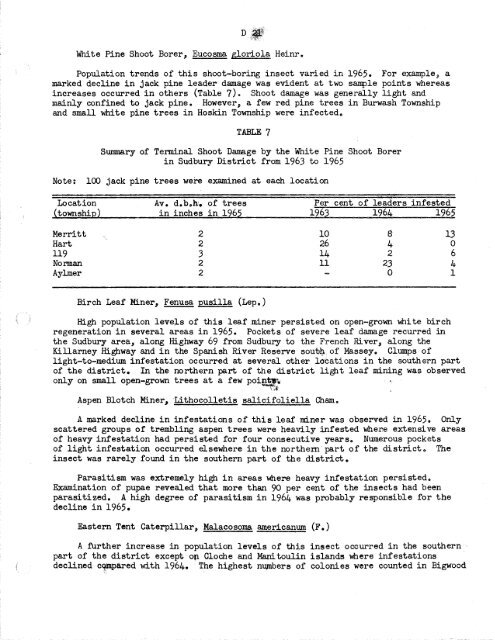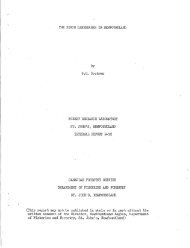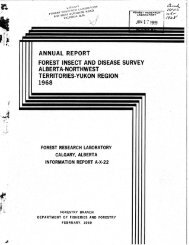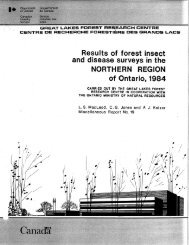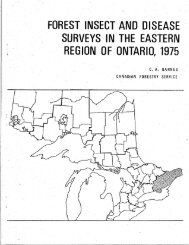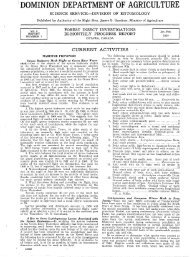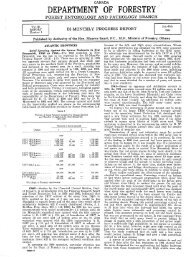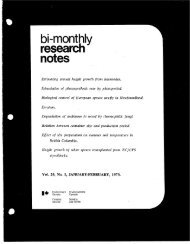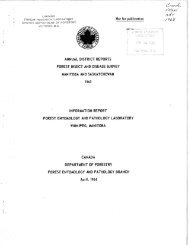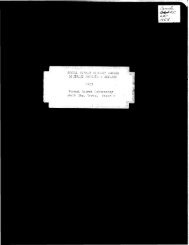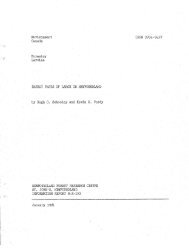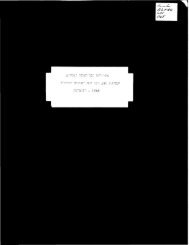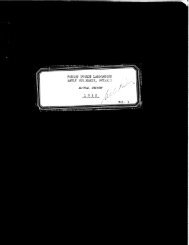- Page 1 and 2:
ANNUAL DISTRICT REPORTS FOREST INSE
- Page 3 and 4:
FOREST DISTRICTS 1 Kemptville 2 Twe
- Page 5 and 6:
SOUTHEASTERN FOREST REGION 1965 INT
- Page 7 and 8:
A 1 Forest Tent Caterpillar, Malaco
- Page 9 and 10:
SOUTHEASTERN FOREST REGION DISTRICT
- Page 11 and 12:
A 4 STATUS OF TREE DISEASES Armilla
- Page 13 and 14:
A6 Observations made in 1965 reveal
- Page 15 and 16:
A8 TABLE 6 Summary of the Occurrenc
- Page 17 and 18:
Organism A 10 TABLE 7 (continued) H
- Page 19 and 20:
A 11 Cedar Leaf Miners, Argyresthia
- Page 21 and 22:
A 13 Introduced Pine Sawfly, Diprio
- Page 23 and 24:
A 15 TABLE 14 Summary of Eastern Te
- Page 25 and 26:
LINDSAY DISTRICT MILES 10 0 40 20 1
- Page 27 and 28:
A 18 Heavy mortality of late instar
- Page 29 and 30:
A 19 TABLE 17 (continued) Insect Ho
- Page 31 and 32:
A 21 TABLE 17 (continued) Insect Ho
- Page 33 and 34:
A 22 Cherry Ugly-nest Caterpillar,
- Page 35 and 36:
A 24 European Spruce Sawfly, Diprio
- Page 37 and 38:
A 26 Eastern Tent Caterpillar, Mala
- Page 39 and 40:
TWEED DISTRICT EASTERN TENT CATERPI
- Page 41 and 42:
TWEED DISTRICT GRIIASTIWPC X IA/NU-
- Page 43 and 44:
A 29 Frontenac County. This vector
- Page 45 and 46:
A 31 TABLE 18 (continued) Insect Ho
- Page 47 and 48:
STATUS OF INSECTS IN KEMPTVILLE DIS
- Page 49 and 50:
A 34 Pitted Ambrosia Beetle, Corthy
- Page 51 and 52:
A 36 TABLE 12 Summary of Fall Webwo
- Page 53 and 54:
TABLE 14 Summary of Cedar Sawfly La
- Page 55 and 56:
A 39 TABLE 17 Summary of Damage by
- Page 57 and 58:
STATUS OF INSECTS IN ThE PEMBROKE D
- Page 59 and 60:
A42 This insect is of European orig
- Page 61 and 62:
A 44 Alice in Alice Township where
- Page 63 and 64:
A46 Severe defoliation of red pine
- Page 65 and 66:
A 48 Larch Sawfly, Pristiphora eric
- Page 67 and 68:
A 49 Miscellaneous Insects (continu
- Page 69 and 70:
SOUTHWESTERN FOREST REGION 1965 INT
- Page 71 and 72:
B 1 STATUS OF INSECTS European Pine
- Page 73 and 74:
SOUTHWESTERN REGION DISTRICTS 1 LAK
- Page 75 and 76:
B4 TABLE 3 Summary of European Pine
- Page 77 and 78:
B6 White-pine Shoot Borer, Eucosma
- Page 79 and 80:
B TABLE 5 Summary of Shoot Damage b
- Page 81 and 82:
B9 TABLE 6 (continued) Condition No
- Page 83 and 84:
B 11 trees. Fruiting bodies were co
- Page 85 and 86:
B 13 TABLE 8 (continued) Or an]. sm
- Page 87 and 88:
B 15 TABLE 8 (continued) Organism S
- Page 89 and 90:
B 16 Cedar Leaf Miners, Argyresthia
- Page 91 and 92:
B 18 Since 1963 the incidence of at
- Page 93 and 94:
B 20 TABLE 14 Summary of Introduced
- Page 95 and 96:
LAKE SIMCOE DISTRICT MILES 20 10 0
- Page 97 and 98:
sM tA B22 Forest Tent Caterpillar,
- Page 99 and 100:
LAKE SIMCOE DISTRICT MILES 20 40 SP
- Page 101 and 102:
B 25 A. Poplar Leaf Roller, Pseudex
- Page 103 and 104:
Insect B 27 TABLE 20, (continued) H
- Page 105 and 106:
STATUS OF INSECTS IN THE LAKE HURON
- Page 107 and 108:
B 30 TABLE 9 Summary of Larch Caseb
- Page 109 and 110:
B 31 Walnut Caterpillar, Datana int
- Page 111 and 112:
B 33 Pine Bud Moth, Exoteleia dodec
- Page 113 and 114:
13 35 TABLE. 17 Summary of Infestat
- Page 115 and 116:
Insect B 37 TABLE 20 (continued) Ho
- Page 117 and 118:
STATUS OF INSECTS IN THE LAKE ERIE
- Page 119 and 120:
B 10 Larch Casebearer, Coleophora l
- Page 121 and 122:
B 42 so severely damaged over a per
- Page 123 and 124:
B 44 This insect causes spiny galls
- Page 125 and 126:
B 46 TABLE 17 (continued) Insect Ho
- Page 127 and 128:
sP.) B48 TABLE 16 (continued) r=loa
- Page 129 and 130:
SOUTH—CENTRAL FOREST REGION 1965
- Page 131 and 132:
C1 STATUS OF TREE DISEASES Dutch El
- Page 133 and 134:
C3 TABLE 3 (continued) Organism Hos
- Page 135 and 136: STATUS OF INSECTS IN THE NORTH BAY
- Page 137 and 138: township 9 1 c6 increase in populat
- Page 139 and 140: Black-headed Jack-pine Sawfly, Neod
- Page 141 and 142: C9 townships Haddo, Caldwell, Crera
- Page 143 and 144: NORTH BAY DISTRICT Eri=11=1;kile*aY
- Page 145 and 146: Insect Archips cerasivoranus Fitch
- Page 147 and 148: STATUS OF INSECTS IN THE PARRY SOUN
- Page 149 and 150: C 15 TABLE 5 Summary of European Sp
- Page 151 and 152: Clg TABLE 8 Summary of Dissections
- Page 153 and 154: C 18 TABLE 10 Summary of Malacosoma
- Page 155 and 156: PARRY SOUND DISTRICT RED—HEADED P
- Page 157 and 158: TABLE 16 Summary of Damage by the W
- Page 159 and 160: C 23 TABLE 18 (continued) Insect Ho
- Page 161 and 162: CENTRAL FOREST REGION 1965 STATUS O
- Page 163 and 164: TABLE 1 D White Pine Weevil, Pissod
- Page 165 and 166: D3 • The greatest expansion occur
- Page 167 and 168: CENTRAL FOREST REGION 1 WHITE RIVER
- Page 169 and 170: D 5 STATUS OF TREE DISEASES Central
- Page 171 and 172: D 7 In the remainder of the region
- Page 173 and 174: D 9 Noteworthy Diseases, (continued
- Page 175 and 176: Diseases and Organisms of Forest Fl
- Page 177 and 178: STATUS OF INSECTS IN THE SAULT STE.
- Page 179 and 180: D TABLE 5 Summary of Larval Counts
- Page 181 and 182: D 16 Western Tent Caterpillar, Mala
- Page 183 and 184: D 18 TABLE 12 Summary of Miscellane
- Page 185: STATUS OF INSECTS IN THE SUDBURY DI
- Page 189 and 190: D TABU. 9 Summary of Red-headed Pin
- Page 191 and 192: SUDBURY DISTRICT MULL mar°. ®, &M
- Page 193 and 194: TABLE 11 Summary of Balsam-fir Shoo
- Page 195 and 196: D 27 TABLE 12 (continued) Insect Ho
- Page 197 and 198: STATUS OF INSECTS IN THE CHAPLEAU D
- Page 199 and 200: D 30 reproduction in the district s
- Page 201 and 202: D 32 Black-headed Jack-pine Sawfly,
- Page 203 and 204: A Leaf Folding Sawfly, Phyllocolpa
- Page 205 and 206: D 35' attacked and a large area of
- Page 207 and 208: D37 Insect Miscellaneous Insects (c
- Page 209 and 210: D 38 Ugly-nest Caterpillar, Archips
- Page 211 and 212: D39 An Aphid on Jack-pine, Cinara c
- Page 213 and 214: GOGAMA DISTRICT C .._ 4111111111111
- Page 215 and 216: D 42 Aspen Blotch Miner, Lithocolle
- Page 217 and 218: D 43 Summary of Larval Mortality an
- Page 219 and 220: D 45 Red-headed Jack-pine Sawfly, N
- Page 221 and 222: D47 TABLE 20 Summary of Damage Caus
- Page 223 and 224: Insect D 49 TABLE 22 (continued) Ho
- Page 225 and 226: D 50 STATUS OF INSECTS Black-headed
- Page 227 and 228: D 52 Western Tent Caterpillar, Mala
- Page 229 and 230: D 54 Spruce Bud Gall Midge, Rhabdop
- Page 231 and 232: D 56 Miscellaneous Insects (continu
- Page 233 and 234: INTRODUCTION Northern Forest Region
- Page 235 and 236: E2 Leaf Blight, Linospora tetraspor
- Page 237 and 238:
e ample s in E 3 A Leaf and Twig Bl
- Page 239 and 240:
Hypoxylon pruinatum Lachnella agass
- Page 241 and 242:
E 7 TABLE 4 (continued) Puccinia ma
- Page 243 and 244:
E 8 STATUS OF INSECTS Gall Aphids o
- Page 245 and 246:
E 10 European Spruce Sawfly, Diprio
- Page 247 and 248:
E 12 Egg bands of the forest tent c
- Page 249 and 250:
E14 TABLE. 14 (continued) Location
- Page 251 and 252:
Larch Sawfly, Pristiphora erichsoni
- Page 253 and 254:
COCHRANE DISTRICT di rm" 42EVA •
- Page 255 and 256:
S E. 19 TABLE 20 (continued) Galeru
- Page 257 and 258:
E 20 Black-headed Budworm, Acleris
- Page 259 and 260:
E 22 A Root Weevil, Hylobius warren
- Page 261 and 262:
KAPUSKASING DISTRICT DT ...141114..
- Page 263 and 264:
E 25 TABLE 11 Summary of Damage by
- Page 265 and 266:
E27 The examination of 71 leaf fold
- Page 267 and 268:
E 29 Larch Sawfly, Pristiphora eric
- Page 269 and 270:
E31 TABLE 21 Summary of Miscellaneo
- Page 271 and 272:
KAPUSKASING DISTRICT CLAY, DOWNER I
- Page 273 and 274:
E32 Ugly-nest Caterpillar, Archips
- Page 275 and 276:
SWASTIKA DISTRICT L___, 461:4:;:aws
- Page 277 and 278:
E 35 TABLE 10 Summary of Forest Ten
- Page 279 and 280:
White-pine Weevil, Pissodes Peck. E
- Page 281 and 282:
E 39 A Poplar Leaf Roller Pseudexen
- Page 283 and 284:
E Insect Host(s) Remarks Lithocolle
- Page 285 and 286:
MIDWESTERN FOREST REGION 1965 STATU
- Page 287 and 288:
F 1 STATUS OF INSEcTS Larch Sawfly,
- Page 289 and 290:
MIDWESTERN FOREST REGION DISTRICTS
- Page 291 and 292:
F4 TABLE 4 Severity of Pollaccia ra
- Page 293 and 294:
F 6 TABLE 6 (continued) Organism Ho
- Page 295 and 296:
STATUS OF INSECTS IN THE ,PORT ARTH
- Page 297 and 298:
4. " F 9 A Bark Beetle of the Gener
- Page 299 and 300:
11 Western Tent Caterpillar, Malaco
- Page 301 and 302:
12 TABLE 12 Summary of Per cent of
- Page 303 and 304:
F 14 TABLE 15 (cont'd.) Summary of
- Page 305 and 306:
F 16 TABLE 17 Summary of Damage by
- Page 307 and 308:
F18. TABLE 19, Port Arthur District
- Page 309 and 310:
F 19 STATUS OF INSECTS Birch Skelet
- Page 311 and 312:
F 2:L TABLE 10 Summary of Western T
- Page 313 and 314:
1' 23 TABLE 14 Summary of Damage by
- Page 315 and 316:
tA Insect F 25 TABLE 16 (continued)
- Page 317 and 318:
V 27 TABLE 16 (continued) Insect Ho
- Page 319 and 320:
INTRODUcTION Western Forest Region
- Page 321 and 322:
G2 TABLE 1 (continued) Per cent egg
- Page 323 and 324:
4 196 G 3 TABLE 2 (continued) Locat
- Page 325 and 326:
G 5 TABU 4 (continued) Av. no. egg
- Page 327 and 328:
G 7 Summary of New Infection of Hyp
- Page 329 and 330:
G 9 Incidence of Infected Shoots at
- Page 331 and 332:
G 11 TABLE 11 (continued) Organism
- Page 333 and 334:
STATUS OF INSECTS IN THE SIOUX LOOK
- Page 335 and 336:
G 14 TABLE 12 Summary of Damage cau
- Page 337 and 338:
G 16 Western Tent Caterpillar, Mala
- Page 339 and 340:
G 18 Small numbers of Neodiprion ni
- Page 341 and 342:
G 20 Larch Sawfly, Pristiphora eric
- Page 343 and 344:
G 22 TABLE 25 (continued) Nepytia c
- Page 345 and 346:
G 23 Black-headed Budworm, Acleris
- Page 347 and 348:
DISTRICT OF KENORA JAcK PINE BUDWOR
- Page 349 and 350:
G 26 Balsam-fir Sawfly, Neodiprion
- Page 351 and 352:
G 28 TABLE 18 Summary of Leader Dam
- Page 353 and 354:
G 30 TABLE 20 (continued) Insect Ho
- Page 355 and 356:
Tetralopha aplastella Clem. Tetralo
- Page 357 and 358:
G 33 Spruce Budworm, choristoneura
- Page 359 and 360:
G 35 where varying degrees of infes
- Page 361 and 362:
G 37 TABLE 18 Summary of Red-headed
- Page 363 and 364:
G 39 Pine Tortoise Scale, Toumeyell
- Page 365 and 366:
WHITE GRUBS, Phyllophaga spp. Sever
- Page 367 and 368:
GREEN-STRIPED MAPLEWORM, Anisota ru
- Page 369 and 370:
FOREST TENT CATERPILLAR, Malacosoma
- Page 371 and 372:
JACK-PINE SAWFLY, Neodiprion pratti
- Page 373 and 374:
EASTERN TENT CATERPILLAR, Malacosom
- Page 375 and 376:
LARCH SAWFLY, Pristiphora erichsoni
- Page 377 and 378:
PINE TORTOISE SCALE, Toumeyella num
- Page 379 and 380:
JACK-PINE BUDWORM, Choristoneura pi
- Page 381 and 382:
A PINE TIP MOTH s Rhyacionia adana
- Page 383 and 384:
PINE ROOT COLLAR WEEVIL, Hylobius r
- Page 385 and 386:
Deterioration of roadside sugar map
- Page 387 and 388:
FOMES ROOT ROT, Fomes annosus (Fr.)
- Page 389:
Frost damage Wind damage in hardwoo


